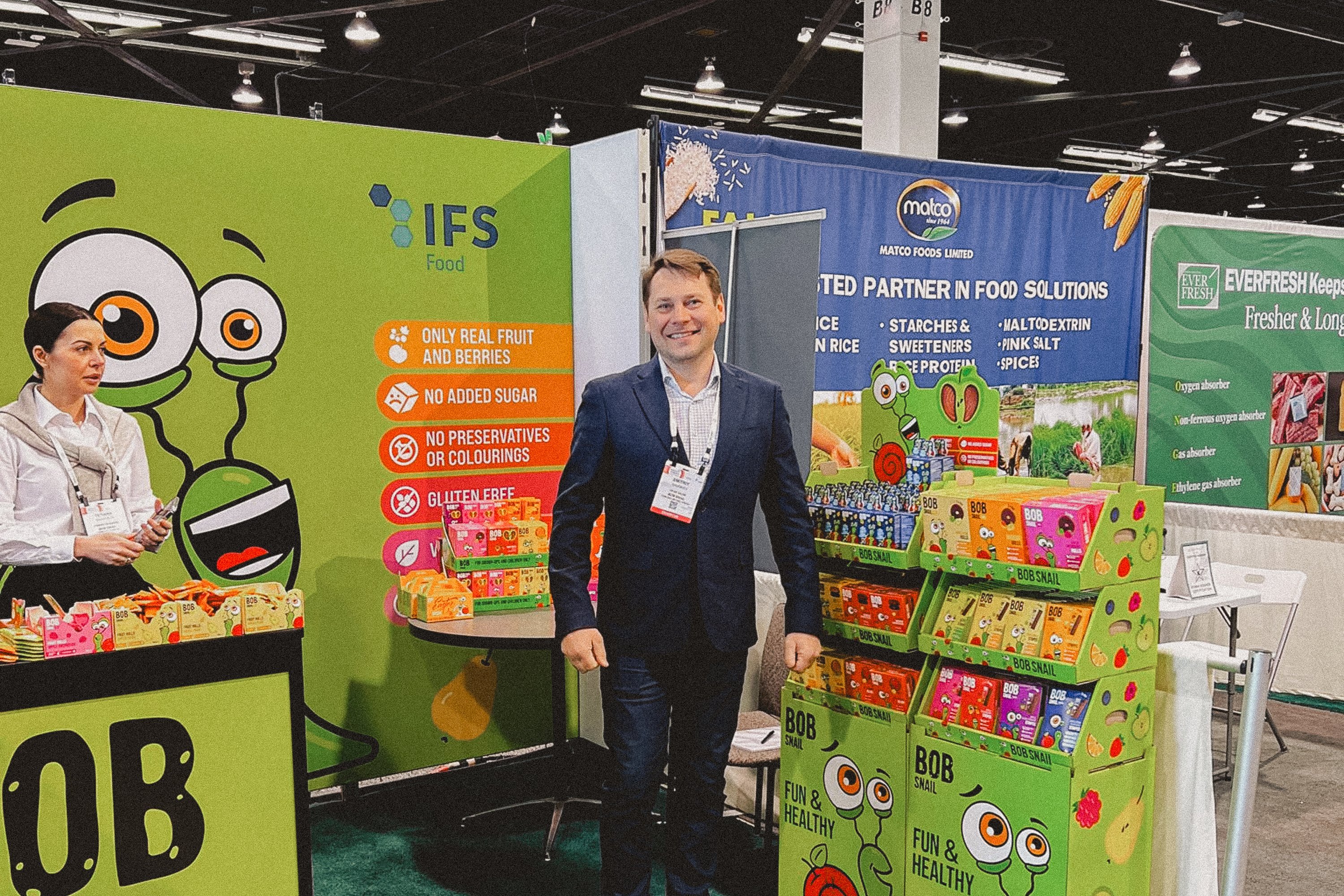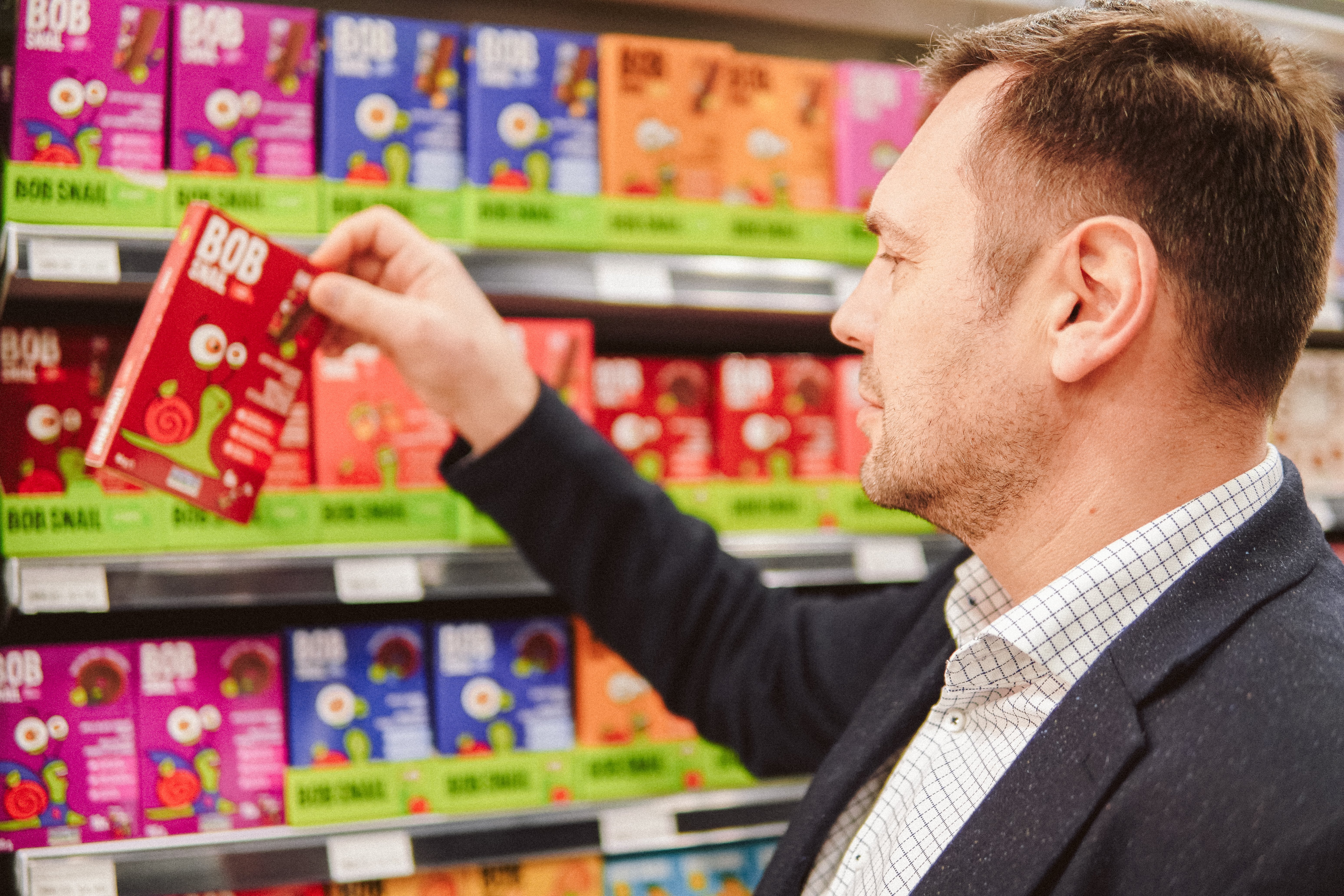At the end of June 2022, Dmytro Shugaiev, who had spent more than a decade working for global giants like Danone, Polpharma, Biocodex, and Biopharma Plasma, landed in Toronto. He had to leave Ukraine following Russia’s full-scale invasion.
In Canada, Dmytro took the lead of the Canadian branch of the Ukrainian healthy fruit snacks brand Bob Snail. In under two years, Bob Snail secured national distribution across Canada, appeared in top retailers like Loblaws, Bulk Barn, Metro, and even broke into Walmart and Whole Foods in the U.S.
YBBP journalist Masha Zhartovska sat down with Shugaiev to talk about breaking into the Canadian market, why Bob Snail is impressing locals with it’s speed and its speed, and which skills Ukrainians are still missing to thrive abroad.
- Bob Snail is a Ukrainian brand of all-natural fruit and berry treats, launched in 2016 in Vinnytsia by Yevhen Shuhayev and Mykhailo Siverchuk. Their first product was the fruit roll called “Bob Snail,” which got its name from its coiled shape (like a snail shell), and “Bob“ was chosen for its simplicity and global appeal. The main distinguishing feature of Bob Snail is that there’s no added sugar, no gluten, no artificial colours or preservatives — just pure fruit.
- In 2018, Bob Snail’s product line expanded to include fruit and berry strips. In 2019, they introduced natural fruit jelly and Belgian chocolate-covered sweets. By 2020, the range had grown to include chef-made purées, smoothies, baby food, and lactose-free desserts made with coconut cream. Today, Bob Snail boasts an impressive 187 products in its lineup.
- Bob Snail’s products are available in 39 countries. They can be found in supermarkets in Belgium, Poland, Hungary, the Czech Republic, Romania, Canada, Australia, the U.S., Latvia, Lithuania, Estonia, the U.K., Iceland, and Japan, as well as on Amazon in the U.S. and Canada. The company now operates subsidiaries in Poland, Canada, the U.S., and Britain.
You hadn’t originally planned to bring the brand to Canada. What changed your mind?
Honestly, it happened because I found myself here. Before Russia’s full-scale invasion, we had no concrete plans to enter the North American market. Until February 2022, I had neither in-depth knowledge of Canada nor any intention to leave Ukraine.
What were your first steps after arriving in Canada?
The first thing you learn here is that without a network, even basic everyday tasks can feel like major projects, never mind starting and growing a business.
So naturally, you try to meet as many people as possible, even if you know that they may not be able or willing to help. I was very fortunate to connect with sincere and competent people who helped me register the company and supported us in many ways.

Did you register a separate company in Canada?
Yes, we registered a Canadian company to import our products from Ukraine and handle sales across the country.
There were reports in the media that you had to redesign your packaging for the Canadian market to reduce plastic use, due to local restrictions. Is that true?
That’s true, but not just because of regulations. We also needed to adapt our packaging for North American consumers. Compared to Europeans, they shop less frequently but are willing to pay for more product in the box.
There’s a long list of requirements in Canada, from the nutrition label format to the rule that all packaging must be in both English and French.
At first, I naively thought we could break into the Canadian market using our Ukrainian packaging with a compliance sticker slapped on. But that only works within ethnic stores, it’s not a viable strategy for broader market entry.

Breaking into the Canadian market doesn’t come cheap. You need patience and deep pockets. How much did you invest?
Quite a bit. It took us nearly two years just to get close to breaking even.
We’re talking about the North American market, meaning Canada and the U.S. How do they compare from your perspective?
Canada’s market is about eight times smaller than the U.S. In my experience, Americans are more business-driven, everything’s faster and more aggressive. Canada moves at a much slower pace, but at the same time, it’s not as aggressive as in the U.S. and with a sense of long-term stability. Canadians tend to care more about work-life balance.
From my experience, the Canadian concept of work-life balance may be hard to grasp for us. Even getting a chance for initial negotiations takes time and persistence. What other hurdles have you come across?
Well, for starters, you’ve got over 40 million people spread out across the second-largest country in the world. It takes about three months to ship a container from Vinnytsia to Vancouver. And by Ukrainian law, we have to pay for the goods within 180 days.
The shipping alone takes around 90 days, and then the product sits in a Canadian warehouse for another 45 to 60 days. In the beginning, it felt like our supply chain had more unknowns than solid figures, which made it extremely difficult to predict demand and manage stock efficiently.
Did you get any support from the Ukrainian Embassy in Canada or industry-related business associations?
I would like to thank our embassy for the opportunity to import Ukrainian products to Canada duty-free. That’s the result of the work done by the Ministry of Foreign Affairs, which oversees the embassy, in collaboration with the Canadian government. This is one of the factors that makes brands like ours competitive on local supermarket shelves. As for specific support from the Ukrainian Embassy, I personally did not reach out to them, and they never contacted us either, which is a bit surprising, especially considering I haven’t seen any other Ukrainian food brands with nationwide distribution in Canada beyond ethnic grocery stores.
Early on, I did approach the Canada-Ukraine Chamber of Commerce (CUCC) and some representatives of the Ukrainian community, but with no result. Now that we’ve built everything ourselves, it’s no longer necessary. And honestly, it’s good to know you don’t owe anyone anything.

From my experience, Canadians often say it’s not so much about what you can do, but who you know.
I haven’t heard that directly from Canadians, but networking here is very important. People start building relationships as early as school and college, and for newcomers like us, it’s definitely tougher to get your foot in the door. On the other hand, we make up for what we lack in connections at the beginning with tech-savviness and drive. After two years, I can say with confidence that the connections come with time. The speed of our success here shows that it’s ultimately your skills and abilities, not your starting advantage, that make the difference.
What were your first steps launching Bob Snail in Toronto?
To get a better sense of the Canadian market, I had a small batch of product shipped from Ukraine. While it was in transit, I studied local stores myself. I didn’t have access to market analytics, so I had to rely on my experience — after all, I’ve been in this industry for over 20 years.
The Canadian market has its own specifics, but overall, the structure is familiar: 20% of retailers account for 80% of sales, and they’re the toughest to reach. But there are plenty of regional chains and local stores where it’s easier to get started.
When the first shipment arrived, I loaded product samples into my car and drove straight to one of those chains. No appointment, just walked in, asked to speak with a buyer. I convinced him to give us a chance. I don’t even remember exactly what I said, just that I wouldn’t leave without an answer. And somehow, it worked. I installed our first three Bob Snail displays myself. Then came the wait. Some so-called ‘experts’ even told me I should send everything back, that it wouldn’t sell in Canada.
But within a few days, while I was circling those tree displays, it became clear: the sales were strong. Three days later, our next order. That’s when I knew — we were in. I used that success and scaled it, first on my own, and later with a team behind it.
Canada is often criticized for monopolies. From your experience, how hard is it to get on supermarket shelves here?
It’s definitely a challenge, but not purely because of monopolies. The real issue is how conservative the market is. Often, category managers simply aren’t interested in new brands or suppliers. They stick with big-name suppliers and focus heavily on promoting own-labelled products, so smaller players like us aren’t always met with much enthusiasm.
Some might say this is typical for most European markets, but the situation is even more challenging in Canada because of the lack of competition among major national chains. If someone like Lidl entered the game, the local giants would have to wake up, which might be exactly why they’re not here yet. So yes, there are definitely monopoly features.
That said, we’ve already made it onto the shelves of Loblaw, the biggest chain in the country. And we’re currently working on expanding into several other national retailers. The monopoly isn’t so much about getting through to the chais, but about the market structure. You don’t see European banks or supermarkets here because real competition isn’t particularly welcomed.
How long did it take you to get into Loblaw?
We landed our contract about six months after entering the Canadian market. Today, you’ll find Bob Snail on the shelves of roughly 400 Loblaw stores. From the first meeting with their category manager to getting the first order in, it took a year and two months.

What tools work best in Canada — networking, social media?
Hands down, personal connections. Your best shot is at industry trade shows. That’s where you can have a real conversation with a buyer. Each buyer handles a specific category and only has a small ‘window’ once or twice a year to consider new products. They’re flooded with emails daily and don’t have time for everyone. New items usually reach them through brokers and distributors. If a buyer’s interested, you send in samples, wait for feedback, and if all goes well, you start selling.
I used to think LinkedIn would open doors here, but not in our case. You can’t get into retailers like Loblaw or Walmart through social media. Only persistent, hands-on work and face-to-face contact will get you through the door.
Speaking of LinkedIn, how useful is it in Canada?
Pretty much the same as in Ukraine. If you’re well-established in the industry, you don’t really need LinkedIn — people know who you are, and even if they don’t, there are always a few mutual contacts. A few phone calls — and it’s all sorted by the end of the day. But if you’re just starting and don’t have that network yet, it can be a very useful, and sometimes the only tool. Although, to be honest, there’s a lot of spam on LinkedIn these days. It can be annoying when bots keep trying to sell you logistics services from Bangladesh for the Canadian market.
Your products are also available in Whole Foods — a major American chain with stores across Canada. How did that happen?
Funny enough, although Whole Foods is American, our products are currently only available in their Canadian stores. It all started at a trade show two years ago, when one of their category managers showed interest in Bob Snail. We followed up religiously for six months before they officially brought us in. But even when we were already listed, we weren’t in the planogram, so we had to manually go store by store for nearly a year to keep the product on the shelves. Only after that were we given official shelf space, and now our product sells steadily with no need for additional effort.

From your story, it seems like you’ve been “kicking doors open,” which isn’t exactly how things usually work in Canada, where emails are long and meetings are booked well in advance…
I wouldn’t say we kick doors open — nobody likes that. But yes, we’re persistent and have big ambitions. The feedback we get from locals confirms that we’re moving at a pace that’s faster than what the Canadian market is used to. Still, it’s slower than we’d like, and definitely slower than if we were building this back in Ukraine. This kind of path takes strong internal drive, and you have to constantly recharge that battery to keep going.
Are there any particular traits in how Canadians choose what to buy and what they pay attention to?
For the most part, Canadians are pretty conservative shoppers. There’s a core list of groceries that stay in their shopping carts for years without much change. Launching a new brand would’ve been much harder if we had targeted adults or seniors. But our focus is on kids and younger consumers, they’re way more open to trying something new. Plus, the healthy eating trend is on our side.
So our approach is simple: get noticed, build a connection through media, and let the brand do the rest.
In Canada, our product category is less developed than in Europe. So we’re not just entering the market — we’re helping to shape it. It makes things trickier, but also opens the door to huge potential.
We aim to enter three retail categories at once. Sometimes we hit all three, sometimes just one.
The first is the checkout aisle. You could place a can of peas there, and it would sell — it’s all about visibility. Our packaging is bright and eye-catching, designed to catch the eye and sell on impulse. When we’re at checkout, sales spike.
The second is confectionery. People buy Bob Snail because it tastes good. They’re looking for flavour in candies and snacks — and we’re not just tasty, we’re healthy too.
The third is natural food. That’s the most innovative category, where people often make “first-time” purchases, trying something new. And we fit in there very naturally.

How are European markets different from the North American ones?
The retail landscape is totally different in North America. In Europe, you’ve got loads of small neighbourhood shops where people pop in on foot, buy something to carry in a bag, and head home. So there are more stores, they’re smaller, and if you get 2–4 SKUs into a chain, you automatically appear in planograms across thousands of locations. It’s straightforward and efficient.
In Canada, it’s a completely different story. There are a few major retailers, and people usually drive to a large store once a week to do their shopping. If you enter a chain with 2–4 SKUs, there’s a risk you’ll just get lost on the shelf. And if your product happens to be out of stock, no one’s rushing to fix it, the space just sits empty. You’re responsible for tracking stock and maintaining shelf presence, and that’s tough when you’re working with limited resources.
Take Poland, for example. If you enter a chain, you instantly show up on the shelves of thousands of stores. Biedronka has over 3,700 locations, Żabka has more than 11,500. In Canada, the entire market is around 4,000 stores, accounting for 80% of total sales. But another 20,000 smaller-format stores are scattered across the country. And if you enter with just one SKU, there’s a real chance it’ll disappear in the crowd. That’s why it’s critical here to claim real shelf space from the very beginning.
Does the brand’s Ukrainian origin help you in Canada?
We’ve never built our strategy around the fact that we’re a Ukrainian brand. We’re proud of it, but it’s not the core of our strategy. The reality is, there’s not much trust here in Eastern European products, and we’re trying to change that with our example. For many buyers, a Ukrainian label is more of a potential issue than a benefit.

There’s this idea that Ukrainians sometimes lack soft skills — that we struggle to pitch ourselves or our products in Western markets, where making a fast impression is key. How do you handle pitching?
I wouldn’t generalize. It’s more about the individual than the nationality. I belong to a generation taught to be modest. We believe that results should speak for us, not words. The younger generation of Ukrainians presents themselves quite well, though our presentation style differs from that in the West.
We tend to use teaser-style presentations, where you spark interest and leave room for imagination. For example, if I say, “A guy went for a walk,” you might imagine him going outside, playing football, or doing something else. Canadians, however, will want to know exactly where he went because everything is taken literally. So you need to be precise with your words. Knowing we might not get a second meeting, we try to lay all the cards on the table in that very first meeting.
I’ve heard a few times from Canadians that Ukrainians can be very direct, sometimes overstep personal boundaries, and occasionally come off as quite blunt. But here’s what I really want to ask: what can we offer Canadians, and what can we learn from them?
Let’s take a step back and look at the last five generations in Canada and compare that to Ukraine: World War I, a revolution, civil war, the Holodomor, World War II, Stalinist repressions, rebuilding the country, the fall of the Soviet Union, the chaotic '90s, constant crises and revolutions — and now a full-scale war again.
I’d like to see how Canadians would have turned out if they had been through what we have.

What’s the best way to build a network in Canada? Are people open to sharing contacts?
Pretty much the same as anywhere else: you connect with people at work, through friends, neighbours, volunteering, or even just being out and about. If you’re naturally sociable, it all goes smoother. If you’re more reserved, it takes a bit more time. The key is to be moderately active, sincere, positive, and open — then networking happens naturally. Networking isn’t some rigid task where you sit down and say, “Okay, from 9 to noon I’ll network and collect five new contacts.”
Describe the typical Bob Snail consumer in Canada.
They’re the same as anywhere else — people who care about what they eat and want to avoid unnecessary gluten, sugar, artificial flavours, or additives. About 70% of our target audience is children. Of course, it’s the parents who pay, but 70% of the consumers are kids, and 30% are adults.
Who are your main competitors here?
We’ve got plenty because our market is literally the human stomach. The less room there is for something else, and the more room for us, the better. That’s why we don’t separate competitors into direct and indirect. We look at what people are eating overall.
We talked about how the Canadian market can be conservative, but what about consumers themselves? If they’ve been eating the same candy for 15 years, they’ll probably keep eating it for 15 more…
Yes — and let’s not forget maple syrup. But the good news is, our core customer is the younger generation. They’re not conservative at all. They live in cities, they travel, they love trying new things. They don’t watch cable, they shop online, and they’re happy to engage with new ideas. So no, we don’t really feel that conservatism. Things get more complicated when we talk about certain communities — they each have their own set of preferences.
Taste preferences, you mean?
Exactly. And those are hard to break into. It’s easier with Canadians in general, especially when it comes to kids. We’ve realized that one of the biggest concerns for moms is what to pack in their child’s lunchbox. Our marketing strategy is built around addressing that specific issue.
How are sales looking now?
We’ve already hit the one-million mark here.

Is 50 million the goal?
That’s right. I’ve run the numbers a few different ways, and each time the potential lands around that figure. So that’s what we’re aiming for.
And what’s your top-selling item?
Everything sells well. We don’t have any “dead” SKUs, nor do we have one clear top-seller.
What advice would you give to Ukrainian entrepreneurs planning to enter the Canadian market?
It depends on your business size and model. What works for a small company won’t work for a big one, and vice versa. Don’t assume this market is going to be easy. And don’t even think about investing before you’ve done your “homework”— registering your business, getting the right permits, adapting your packaging. The approach of “we’ll start and fix it along the way“ doesn’t work here. Canada’s a high-compliance market, and even small slip-ups can come with big consequences.
Also, don’t count on finding a partner who will do everything for your brand — that’s not how things work. I strongly recommend investing in research and gathering insights from the beginning. Get advice from someone who’s already working here. It’ll be much cheaper than learning everything the hard way.
And finally, what do you believe in working in this market?
A bigger purpose. It’s tough on my family, no doubt. I’m working 16 hours a day, seven days a week. But I don’t treat any part of this job as unimportant. The operational side takes a lot of energy, but I know exactly why I’m doing it. This isn’t my first time launching in a new market where I’ve been told there are local rules, which then ended up changing. It’s like a glass of cold water — if you add one drop of hot water, the whole glass gets a bit warmer. Every person who comes to a new market brings ideas, experience, and ends up changing that market, even just a little.




